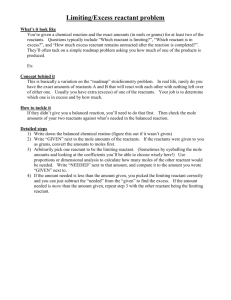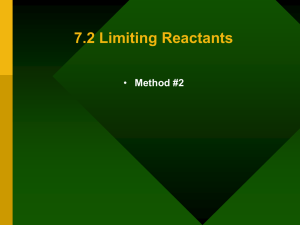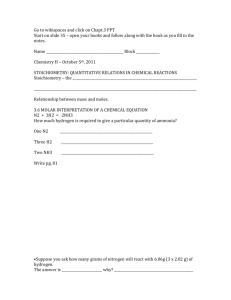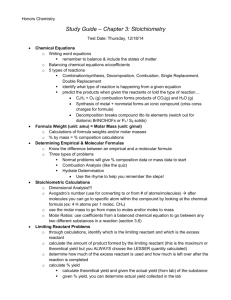Limiting Reagents Notes
advertisement
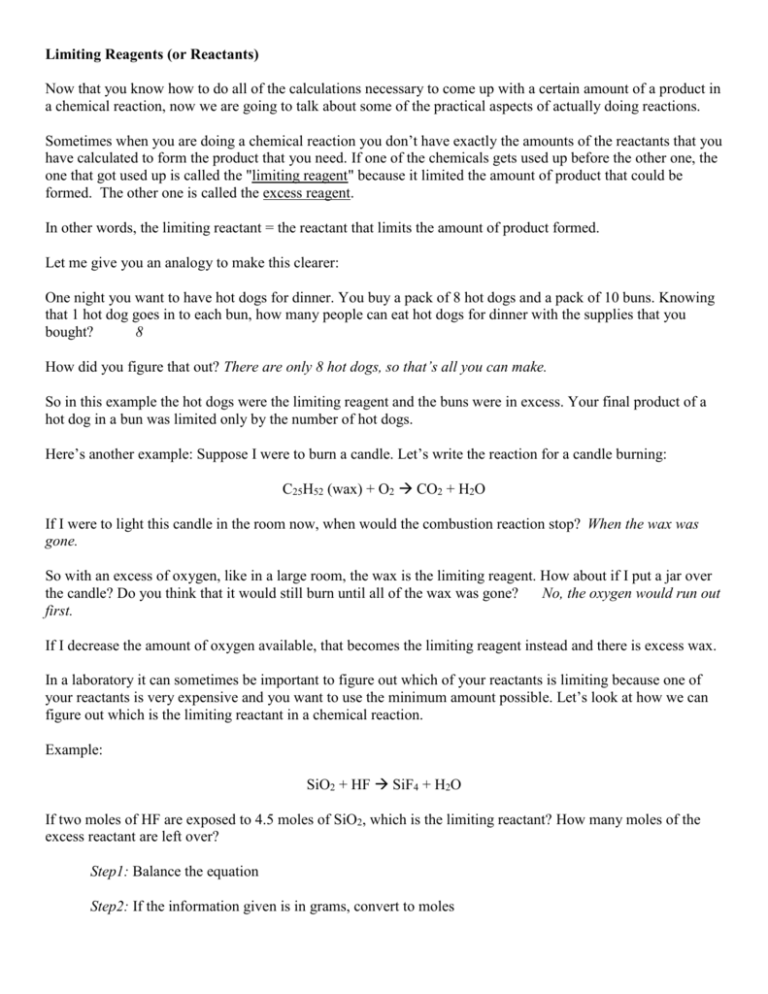
Limiting Reagents (or Reactants) Now that you know how to do all of the calculations necessary to come up with a certain amount of a product in a chemical reaction, now we are going to talk about some of the practical aspects of actually doing reactions. Sometimes when you are doing a chemical reaction you don’t have exactly the amounts of the reactants that you have calculated to form the product that you need. If one of the chemicals gets used up before the other one, the one that got used up is called the "limiting reagent" because it limited the amount of product that could be formed. The other one is called the excess reagent. In other words, the limiting reactant = the reactant that limits the amount of product formed. Let me give you an analogy to make this clearer: One night you want to have hot dogs for dinner. You buy a pack of 8 hot dogs and a pack of 10 buns. Knowing that 1 hot dog goes in to each bun, how many people can eat hot dogs for dinner with the supplies that you bought? 8 How did you figure that out? There are only 8 hot dogs, so that’s all you can make. So in this example the hot dogs were the limiting reagent and the buns were in excess. Your final product of a hot dog in a bun was limited only by the number of hot dogs. Here’s another example: Suppose I were to burn a candle. Let’s write the reaction for a candle burning: C25H52 (wax) + O2 CO2 + H2O If I were to light this candle in the room now, when would the combustion reaction stop? When the wax was gone. So with an excess of oxygen, like in a large room, the wax is the limiting reagent. How about if I put a jar over the candle? Do you think that it would still burn until all of the wax was gone? No, the oxygen would run out first. If I decrease the amount of oxygen available, that becomes the limiting reagent instead and there is excess wax. In a laboratory it can sometimes be important to figure out which of your reactants is limiting because one of your reactants is very expensive and you want to use the minimum amount possible. Let’s look at how we can figure out which is the limiting reactant in a chemical reaction. Example: SiO2 + HF SiF4 + H2O If two moles of HF are exposed to 4.5 moles of SiO2, which is the limiting reactant? How many moles of the excess reactant are left over? Step1: Balance the equation Step2: If the information given is in grams, convert to moles Step 3: Convert moles of each reactant in to moles of one product, using stoichiometry. Step 4: The limiting reactant is the one that makes less product Step 5: Calculate how many moles of the excess reactant are used by setting up a stoichiometric ration between the two reactants. Step 6: Calculate how many moles of the excess reactant are left over by subtracting moles used from moles that you have given in the problem. Here is how to do this problem: SiO2 + 4HF SiF4 + 2H2O SiO2 1 4.5 SiF4 1 X X = 4.5 moles of SiF4 possible HF 4 2 SiF4 1 Y Y = 0.5 moles of SiF4 possible Therefore, the HF is the limiting reactant because when it runs out the reaction stops and less product can be made than if all of the other reactant were able to be used up. SiO2 is the excess reactant Calculate how many moles of it are used before the HF runs out: SiO2 1 X HF 4 2 X = 0.5 moles are used. If we have 4.5 moles, that means that 4.0 moles are left unused.


